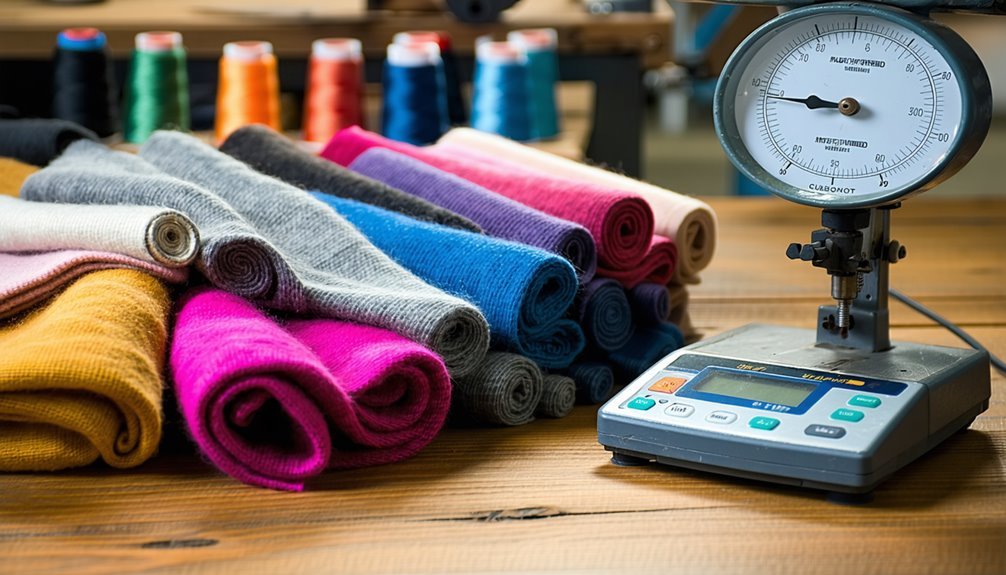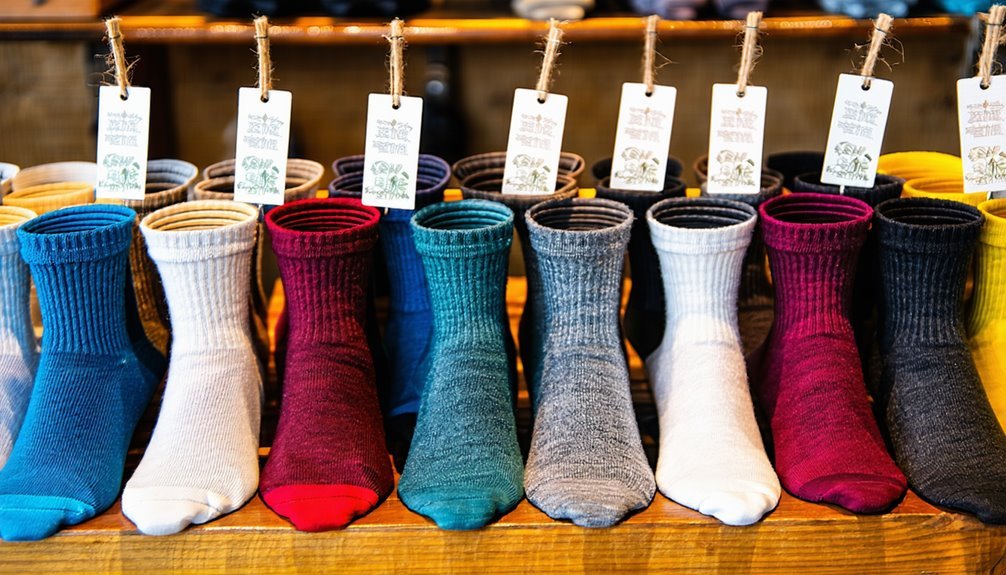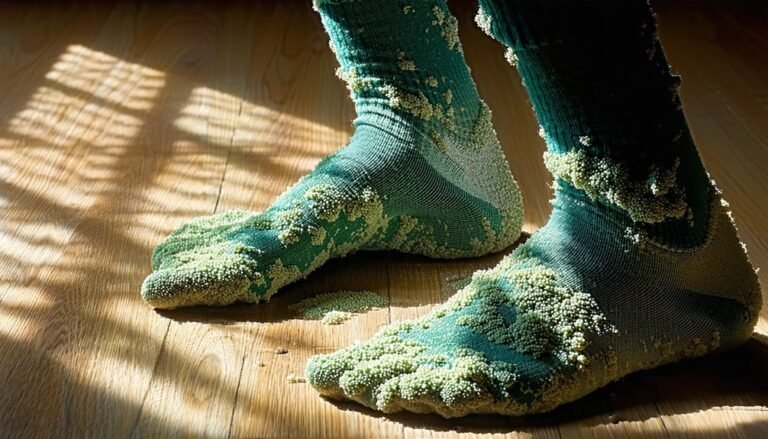How Are Sock Prices Detewerminied
Sock prices are influenced by various factors, including material quality, labor practices, and brand reputation. Sustainable materials and ethical manufacturing often lead to higher costs, while effective marketing can elevate perceived value. Retail markup strategies also play a significant role, affecting how consumers perceive quality versus price. Seasonal trends and consumer behavior further sway prices and demand. If you're curious about how these dynamics play out across different brands, there's much more to uncover.
Materials and Production Costs

When you think about sock prices, the materials and production costs play an essential role in determining how much you'll pay. The quality of material sourcing directly impacts the final price; sustainable and high-quality fibers often come with a premium. For instance, organic cotton or merino wool may cost more, but they provide better comfort and durability, which many consumers prioritize for safety reasons. Additionally, production efficiency can greatly affect costs. Brands leveraging advanced manufacturing technologies may reduce waste and lower prices without compromising quality. As you consider your sock purchases, keep in mind that investing in materials and efficient production often results in a safer, longer-lasting product—ultimately offering better value for your money in the long run.
Labor and Manufacturing Processes
Although some may overlook the significance of labor and manufacturing processes, they are essential in shaping sock prices and overall quality. The effectiveness of labor practices directly influences manufacturing efficiency, which in turn affects production costs. When manufacturers prioritize safe working conditions and fair wages, they often see a boost in employee morale and productivity, leading to superior products. Furthermore, advancements in technology can streamline manufacturing processes, reducing waste and lowering costs. However, these innovations must be balanced with ethical labor standards to guarantee quality socks. As consumers become more conscious of these factors, they increasingly demand transparency, pushing brands to adopt responsible practices. Ultimately, the interplay between labor and manufacturing will determine how much you're willing to pay for your socks.
Brand Reputation and Marketing
The relationship between labor practices and manufacturing efficiency sets the stage for how brand reputation and marketing shape sock prices. Strong brand loyalty often stems from effective marketing campaigns that leverage social media and influencer partnerships. These strategies not only enhance consumer perception but also establish a compelling brand storytelling narrative. By utilizing advertising strategies that include product placement and sponsorship deals, brands can reach targeted audiences more effectively. Promotional offers further entice consumers, encouraging them to choose one brand over another. Ultimately, a well-executed marketing plan can drive sock prices higher, as customers are willing to pay a premium for brands they trust. Your perception of quality and safety directly impacts your purchasing decisions.
Retail Markup Strategies

Retail markup strategies play an essential role in determining the final price consumers pay for socks. By understanding markup psychology, retailers can effectively position their products to maximize profit while ensuring customer satisfaction. Common pricing strategies include keystone markup, where prices are doubled, and psychological pricing, which sets prices just below round numbers to create a perception of value. These tactics not only influence purchasing decisions but also cultivate a sense of safety in consumers. When shoppers perceive a fair price for quality socks, they're more likely to trust the brand. Ultimately, effective retail markup strategies balance profitability with consumer confidence, shaping the overall sock market and its appeal to safety-conscious buyers.
Seasonal Trends and Consumer Demand
When you consider sock prices, it's crucial to recognize how seasonal fashion influences consumer choices and demand. During holiday shopping peaks, you'll often see a spike in prices as brands capitalize on festive trends, while weather-driven sales can lead to price fluctuations based on temperature changes. Understanding these patterns can help you anticipate when to buy for the best value.
Seasonal Fashion Influence
As fashion seasons shift, so too does consumer demand, creating a dynamic landscape for sock pricing. You'll notice that trend forecasting plays an essential role here, as brands analyze seasonal styles to predict what consumers will want. For instance, when bold colors and patterns emerge in runway shows, sock designs quickly adapt to meet this demand, often leading to increased prices. Fashion collaborations also greatly influence sock trends; when a well-known designer partners with a sock brand, it elevates the product's perceived value. These collaborations can create urgency among consumers, prompting them to purchase before stock runs out. Ultimately, staying attuned to these seasonal influences helps brands strategically price their socks to align with consumer expectations and market trends.
Holiday Shopping Peaks
With the arrival of the holiday season, sock pricing enters a new phase influenced by intensified consumer demand and gifting trends. Retailers ramp up holiday marketing efforts, targeting buyers motivated by consumer psychology. During this period, shoppers often seek unique, high-quality options that appeal to their desire for thoughtful gifts. This increased demand can lead to price hikes as brands capitalize on the urgency to purchase. Additionally, limited-edition designs or themed collections create a sense of exclusivity, further driving consumer interest. As safety remains a priority, many consumers are also inclined to invest in cozy, comfortable socks for themselves and loved ones. Understanding these dynamics can help navigate the holiday sock market successfully and make informed purchasing decisions.
Weather-Driven Sales Trends
Though weather patterns can fluctuate unpredictably, they play a significant role in shaping sock sales trends throughout the year. You'll notice that during colder months, there's a marked increase in demand for thicker, warmer socks, reflecting the weather impact on consumer choices. Conversely, as temperatures rise, lightweight and breathable fabrics take the spotlight, leading to notable sales fluctuations. Retailers often prepare for these shifts by adjusting inventory and marketing strategies, ensuring they meet safety and comfort needs. Understanding these seasonal trends helps you make informed purchases, aligning your sock wardrobe with the weather. By paying attention to these patterns, you can also anticipate sales events, securing quality products at advantageous prices while keeping your feet cozy and protected.
Geographic Location and Distribution Costs
While many factors influence sock prices, geographic location and distribution costs play a crucial role in shaping the final retail price. The supply chain intricacies can considerably affect costs, as transporting socks from factories to retailers varies widely based on distance and local infrastructure. For instance, socks sold in urban areas might incur higher distribution costs due to congestion and logistical challenges, leading to increased regional pricing. Additionally, local demand fluctuations can dictate how much retailers are willing to charge. Understanding these geographic nuances helps you grasp why some socks are more expensive in certain regions. By being aware of these dynamics, you can make more informed decisions about your sock purchases, ensuring safety and value in your choices.
Quality vs. Price Perception

When you consider sock prices, the materials used play an essential role in shaping your perception of value. Higher-quality fabrics often come with a steeper price tag, but brand reputation can amplify this effect, leading you to associate specific labels with superior performance. Understanding this interplay can help you make more informed purchasing decisions.
Material Impact on Pricing
A significant portion of sock pricing hinges on the materials used in their production, which directly influences both perceived quality and market value. When evaluating sock prices, consider these factors:
- Fiber Quality: Higher-end fibers like merino wool or bamboo not only feel luxurious but also enhance durability.
- Production Sustainability: Eco-friendly materials often come at a premium, reflecting a growing consumer demand for ethical practices.
- Comfort Features: Innovations, like moisture-wicking properties, add value and justify higher costs.
- Brand Transparency: Brands that disclose their sourcing and production methods can command trust and higher price points.
Ultimately, understanding these material impacts helps you make informed decisions, balancing safety, comfort, and budget.
Brand Influence on Value
As consumers navigate the sock market, brand influence plays a crucial role in shaping their perceptions of value, often blurring the lines between quality and price. Brand loyalty is a significant factor, as established brands leverage marketing strategies to create an image of superior quality, even if their products aren't necessarily better. Consumers tend to equate higher prices with better quality, leading to a premium on brand names.
| Brand | Price Range | Perceived Quality |
|---|---|---|
| Brand A | $10 – $15 | High |
| Brand B | $5 – $10 | Medium |
| Brand C | $2 – $5 | Low |
In this landscape, understanding these dynamics helps you make informed choices, ensuring your investments align with your values and needs.
Sustainability and Ethical Considerations
Although many consumers prioritize price and style when shopping for socks, sustainability and ethical factors are increasingly shaping purchasing decisions. You might be surprised to learn that eco-friendly materials and ethical sourcing can influence not just the price but also the perceived value of socks. Here are four key factors to reflect on:
- Material Impact: Socks made from organic cotton or recycled fibers reduce environmental impact.
- Labor Practices: Brands committed to fair labor guarantee that workers are treated ethically.
- Carbon Footprint: Sustainable production methods can lower carbon emissions.
- Transparency: Companies that openly share their sourcing practices often gain consumer trust.
Competition and Market Saturation
Sustainability and ethical considerations have carved out a niche in the sock market, but they also play a role in how brands compete amid increasing market saturation. As new players enter the market, you'll notice that competitive pricing becomes vital for survival. Established brands must adapt their pricing strategies to fend off newcomers while maintaining their loyal customer base. With so many options available, you'll likely see brands emphasizing quality and sustainability to differentiate themselves. The pressure to improve margins and attract consumers leads to innovative designs and materials. As market entry becomes easier for eco-conscious brands, the landscape shifts, making it essential for you to stay informed about trends and prices that reflect both safety and ethical considerations.
Consumer Behavior and Purchasing Habits
When you consider sock purchases, brand influence often plays a pivotal role in your decisions, shaping your perception of quality and value. Seasonal trends also affect when you buy, with certain styles peaking during holidays or colder months. Furthermore, your price sensitivity can greatly dictate which options you choose, highlighting the intricate interplay between these factors in your shopping habits.
Brand Influence on Purchases
How does brand influence shape your decision when buying socks? The impact of a brand often goes beyond the product itself, intertwining with your values and preferences. With so many options available, certain elements draw you in:
- Brand Loyalty: Familiarity fosters trust, making you more likely to choose a brand you've purchased before.
- Packaging Design: Eye-catching packaging can sway your perception of quality and desirability.
- Influencer Marketing: Recommendations from influencers resonate, especially when they align with your interests.
- Online Reviews: Positive feedback from other consumers builds confidence in your purchase.
Understanding these factors helps you navigate the market, ensuring that your choices reflect not just personal taste but also safety and reliability, supported by brand storytelling and social media impact.
Seasonal Trends in Sales
As the seasons change, so do consumer behaviors and purchasing habits, particularly in the sock market. You might notice that fashion cycles influence sock styles, with warmer colors and heavier materials dominating fall and winter, while lighter, vibrant designs take over in spring and summer. Retailers often adjust their promotional strategies accordingly, offering discounts during seasonal shifts to boost sales.
| Season | Popular Styles | Promotional Strategies |
|---|---|---|
| Winter | Wool, thermal socks | Holiday sales, bundling |
| Spring | Cotton, colorful prints | Spring clearance, buy one get one |
| Summer | Ankle, breathable socks | Seasonal discounts, online promotions |
Understanding these trends can help you make informed decisions about your sock purchases throughout the year.
Price Sensitivity Factors
Consumer behavior in the sock market is greatly shaped by price sensitivity factors that fluctuate with economic conditions and individual preferences. Understanding these factors is essential for grasping price elasticity and how it affects consumer choices. Here are four key elements that influence purchasing habits:
- Brand Loyalty: Consumers often stick to familiar brands, making them less sensitive to price changes.
- Economic Climate: In tough times, shoppers prioritize affordability, affecting demand for premium socks.
- Quality Perception: Higher perceived quality can reduce price sensitivity, as customers are willing to pay more for durability.
- Trends and Styles: Current fashion trends can drive demand, impacting how much consumers are willing to spend.
Frequently Asked Questions
How Do Sock Prices Vary Across Different Countries?
Sock prices shift considerably, shaped by currency fluctuations and local demand. You'll notice that countries with stronger currencies often showcase higher prices, reflecting regional preferences and purchasing power. It's a fascinating financial phenomenon!
What Role Do Online Sales Play in Sock Pricing?
Online sales greatly influence sock pricing. With increased online competition, brands adopt diverse pricing strategies to attract buyers. You'll find that these strategies often reflect market demand, ensuring you get competitive prices and safety in your purchases.
How Often Do Sock Prices Change Throughout the Year?
Ever wondered why prices fluctuate? Sock prices often change seasonally, influenced by trends and promotional sales. You'll notice discounts during holidays, but consistent monitoring helps you find the safest deals throughout the year.
Are There Specific Sock Materials That Are More Expensive Than Others?
Yes, certain sock materials, like merino wool or bamboo, often have higher material quality and manufacturing costs. These factors contribute to their increased price, reflecting durability, comfort, and overall value, which many consumers prioritize for safety and longevity.
How Do Consumer Reviews Influence Sock Pricing?
Consumer feedback substantially shapes pricing strategies. When reviews highlight quality or comfort, brands adjust prices to reflect demand. This trend illustrates how consumer preferences directly impact sock pricing, ensuring safety and satisfaction for buyers.







